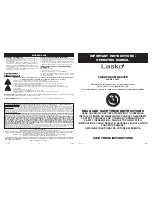
15
ENGLISH
installation, and according to best professional practices.
WATER CONNECTIONS
On completion of all transport or handling operations, always check the tightness of the water fitting ring nuts.
Take particular care when connecting the unit to the water supply. When tightening a fitting, always hold the opposite
fitting steady with a second tool to avoid damage.
Connecting the pipes
Connect up the pipes according to the legend on the unit itself and according to the instructions given in this manual.
b
All pipes must be insulated in conformity to applicable standards.
b
The pipes between the unit and the storage cylinder should be kept as short as possible.
The following materials are recommended for the construction of the piping system: steel or copper for the primary circuit;
galvanised steel, copper or hot water compatible plastic for the secondary circuit. Galvanised pipes and fittings must only
be used in the secondary (DHW) circuit, and care must be taken to avoid electrochemical corrosion.
a
Do not install the unit in gravity feed hot water systems!
- The domestic cold water supply must be fitted with a safety valve conforming to DIN 4753 part 1. The operating pres-
sure of this valve must be equal to the unit’s maximum operating pressure.
- If the pressure of the water supply reaches 10 bar, install a pressure reducer downstream from the water meter.
- The domestic cold water supply must be fitted with a suitable water filter.
- We recommend the installation of a suitably sized potable water expansion vessel.
b
Make sure that the installation position provides easy visibility of and access to the safety valves.
b
Connect the safety valves to a drain in conformity to applicable standards.
b
Make sure that no obstacles are present between the safety valve and the unit.
b
The diameter of the drain pipe must not be smaller than that of the safety valve’s drain fitting. The drain pipe should
be no longer than 2 metres and should have no more than two bends in it. If this length has to be exceeded, incre-
ase the diameter of the pipe. Never exceed 4 metres and 3 bends.
b
Do not install filters or other restrictions.
b
Make sure that the pipes are watertight before securing them in place.
b
Check that all threaded fittings on the unit are tightened to the correct tightening torque (in case they have worked
loose during transport).
b
Make sure that the unit is disconnected from the mains power supply before opening the casing of the control panel!
Summary of Contents for SC ACS 160 E
Page 31: ......
















































